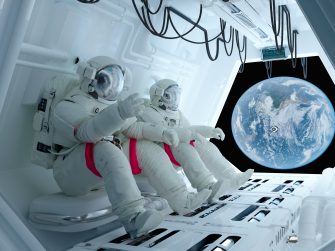NASA Research Will Help Back Pain Treatment Innovations
 What does a spinal-injury patient on bed rest and an astronaut have in common? Maybe more than you think! Patients with limited mobility are subject to some of the same changes seen in micro-gravity. For years, Astronauts have experienced back pain during space flights. Additionally, studies show they are more likely than their Earth-bound peers to suffer back pain and have injuries such as herniated discs after they return to Earth.
What does a spinal-injury patient on bed rest and an astronaut have in common? Maybe more than you think! Patients with limited mobility are subject to some of the same changes seen in micro-gravity. For years, Astronauts have experienced back pain during space flights. Additionally, studies show they are more likely than their Earth-bound peers to suffer back pain and have injuries such as herniated discs after they return to Earth.
In order for them to perform the physical tasks, experiments and be prepared to adapt to new environments, It is important for the astronauts to be healthy on their flights. NASA began looking for the cause of the back pain which would then lead towards treatment and prevention. Astronauts completed an extensive battery of tests and exams prior to the flight and then again after returning to Earth. The selection of exams was done in to provide a comprehensive look at “exposure severity, potential injury mechanisms, and pain generator localization.” The exams will give researchers a clearer picture of the effects of prolonged microgravity. The tests chosen included:
- MRI scans are taken of the lumbar and cervical spine to measure the spinal bones, discs and muscles
- MRS: Magnetic Resonance Spectroscopy measures spinal disc tissues of the lumbar spine.
- Upright MRI (Axial Load): MRI scans in four different conditions: (1) while the subject lies flat on his/her back, (2) while the subject is standing upright with no load on the back, (3) while standing upright but with 10% of the subject’s body weight loaded on the back, and (4) while seated and with the load removed from the back.
- Spinal Kinematics: measures the lumbar spine stiffness and stability using the KineGraph Vertebral Motion Analyzer (VMA). The KineGraph VMA is a system that measures the motion of the bones in the spine using a standard fluoroscope. A fluoroscope is an FDA-approved imaging machine that has been in widespread use for decades, and is used to collect moving video X-ray images of the motion of the spine. In addition to a fluoroscope, the KineGraph VMA also involves the use of a large patient handling device that assists the subject through a series of controlled spine bends while the fluoroscope is collecting images. These large patient handling devices are needed to standardize the bending, so that it is possible to compare the subject’s spinal motion to that of other people. The study consists of taking a series of video X-rays as the subject does different types of spine bending while assisted by the large patient handling devices. The subject bends forward and backward, side-to-side, while standing up, and while lying down.
- Back Pain Questionnaires: Astronauts complete two questionnaires
- Biering-Sorenson: Astronauts perform a strength test of the abdominal and back muscles
The study revealed astronauts experience a significant loss of paraspinal muscle mass during a long-duration mission to microgravity. Researchers also found that only 68% of the muscle mass lost was recovered after more than a month back on Earth. However, the intervertebral disc were unchanged following space flight. Therefore, in order to maintain strength and off-set these changes that micro-gravity has on the human body, scientists must now look for ways to target the lumbar para-spinal muscles before, during and after space flight.
Just as space flight has been a source of technologies that have become part of our everyday life such as cordless tools, memory foam and water filters, the research on back pain can help back-pain patients on earth. Patients with limited mobility are subject to some of the same changes seen in micro-gravity. Therefore, learning more about how space causes spinal degeneration may lead to knowledge that would help doctors diagnose and treat those disorders on Earth. Specifically, this research may lead to innovations that will benefit “patients exposed to long-term bed rest or lack of mobility (spinal-cord injury patients as well as patients suffering lack of exercise, mobility and obesity). This research also applies to abnormal spinal curvature and pain suffered by children wearing heavy backpacks to and from school as well as heavily armed soldiers.”
In the meantime, this study gave further evidence of what chiropractors have been telling patients for a long time – exercise is a vital factor in overall health and well-being and specifically for spinal health. If you are experiencing any type of back pain, see your chiropractor today. You can discuss causes, treatment and what type of exercise would be most beneficial for your situation. If you don’t have a chiropractor, you can find one at https://www.tnchiro.com/find-a-doctor/.
SOURCE: “Risk of Intervertebral Disc Damage after Prolonged Space Flight (Intervertebral Disc Damage)” – 10.18.17 – posted at https://www.nasa.gov/mission_pages/station/research/experiments/856.html